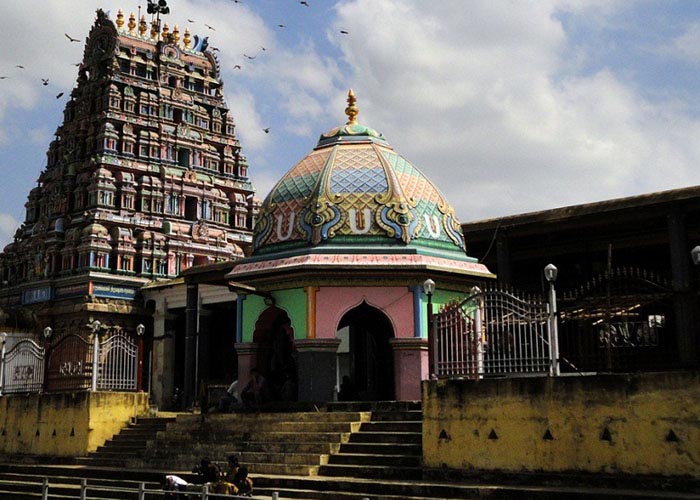Uppiliappan Temple - Oppilliappan Temple

Information of Uppiliappan Temple (Oppilliappan Temple), Kumbakonam, Thanjavur, Tamil Nadu
This temple is also known as Thiruvinagar of Venkatachalapathy temple and is located in a village near Thirunageshwaram on the outskirts of Kumbakonam in Tamil Nadu. This temple is known to be an ancient one and records of it can be found in the Divya Prabandhana which are the early medieveal Tamil canons of the Azhwar saints recorded during the early 6th-9th century AD. This particular temple ranks at number 60 in the 108 Divya Desams that are dedicated to lord Vishnu. In this temple lord Vishnu is worshipped in his diety form called Uppiliappan along with his consort Lakshmi known as Bhumi Devi.
Uppiliappan Temple Religious Significance
The temple is revered due to its antiquity dating back to 8th century AD and also because lord Vishnu had appeared in the form of Upiliappan for the sage Markandeya. The lord is also said to have appeared at this site for the gods Shiva, Brahma and Bhoomadevi. More over the temple is one of the Divya Desams which further sanctifies its reverence. The temple is well known for its daily rituals that place six times and the three major yearly festivals conducted here. One of the most celebrated festivals of this temple is the chariot festival which takes place during the months of March-April which is the month of Chittirai according to the Tamil calendar.
Uppiliappan Temple Mythology & History
The temple's history is recorded in the holy scripture of the Hindus known as the Brahmanda Purana. According to the legend, Tulasi a plant did penance to come closer to Lord Vishnu and pleased the god. She was given a boon by him wherein the goddess would appear in her lap, as a result Tulasi appeared at the temple. It is said that the sage Markandeya worshipped lord Vishnu so that Lakshmi would be born to him as a daughter and Vishnu his son in law. Markandeya took on a holy journey and when he was in Thiruvinnagaram he felt that it was the right place to do penance and get his wish fulfilled. He started his penance here which went on for a thousand years until he was finally blessed by the Goddess Lakshmi. The goddess took the form of a little baby and appeared under the Tulasi plant. Markandeya took the child and raised her as his own for he could feel the presence of the goddess within her. During the month panguni of Shravana when his daughter was in her adolescence lord Vishnu in the form of an old man asked him for her hand in marriage. Markandeya said that the man was too old and his daughter couldn't even cook properly with salt contents. To this he got the reply, "If you daughter must cook without salt, then I will take it as my best food but I will not leave here without marrying her." Markandeya on hearing this sought help from Vishnu and when he opened his eyes he saw the God in his true form. He then married his daughter to him and as a result even to this day the food at the temple is prepared without salt.
Uppiliappan Temple Architectural Importance
The temple has been constructed in the Dravidian style of architecture and is said to have been first built by the Cholas of the Medieval period. The temple complex has different shrines for different Hindu gods however the presiding diety of the temple is Vishnu in the form of Uppiliappan. The main shrine is dedicated to him and is plated with gold. The shrine also has images of Markandeya and Bhoomidevi.
There are two halls in the temple complex. The halls are made of marble and one of them is on the western side while the other on the northern side. There are two more halls but theya re outside the main complex.
The main artifact of importance is the five tiered rajagopuram or the gateway tower which is intricatedly designed with sclupture and figurines of different dieties.
- Andhra Pradesh Temples
- Assam Temples
- Bihar Temples
- New Delhi Temples
- Goa Temples
- Gujarat Temples
- Jammu and Kashmir Temples
- Karnataka Temples
- Kerala Temples
- Madhya Pradesh Temples
- Maharashtra Temples
- Odisha Temples
- Punjab Temples
- Rajasthan Temples
- Sikkim Temples
- Tamil Nadu Temples
- Telangana Temples
- Uttar Pradesh Temples
- Uttarakhand Temples
- West Bengal Temples